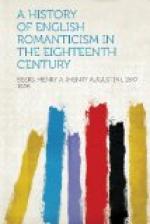“Ipse ego Dardanais
Rutupina per aequora puppes,
Dicam, et Pandrasidos regnum
vetus Inogeniae,
Brennumque Arviragunque duces,
priscumque Belinum,
Et tandem Armoricos Britonum
sub lege colonos;
Tum gravidam Arturo fatali
fraude Ioergernen;
Mendaces vultus, assumptaque
Gorloeis arma,
Merlini dolus."[2]
The “matter of Britain” never quite lost the fascination which it had exercised over his youthful imagination, as appears from passages in “Paradise Lost"[3] and even in “Paradise Regained."[4] But with his increasing austerity, both religious and literary, Milton gravitated finally to Hebraic themes and Hellenic art forms. He wrote Homeric epics and Aeschylean tragedies, instead of masques and sonnets, of rhymed pieces on the Italian model, like “L’Allegro” and “Il Penseroso,” and of stanzaic poems, like the “Nativity Ode,” touched with Elizabethan conceits. He relied more and more upon sheer construction and weight of thought and less upon decorative richness of detail. His diction became naked and severe, and he employed rhyme but sparingly, even in the choral parts of “Samson Agonistes.” In short, like Goethe, he grew classical as he grew old. It has been mentioned that “Paradise Lost” did much to keep alive the tradition of English blank verse through a period remarkable for its bigoted devotion to rhyme, and especially to the heroic couplet. Yet it was, after all, Milton’s early poetry, in which rhyme is used—though used so differently from the way in which Pope used it—that counted for most in the history of the romantic movement. Professor Masson contradicts the common assertion, that “Paradise Lost” was first written into popularity by Addison’s Saturday papers. While that series was running, Tonson brought out (1711-13) an ediction of Milton’s poetical works which was “the ninth of ‘Paradise Lost,’ the eight of ‘Paradise Regained,’ the seventh of ‘Samson Agonistes’ and the sixth of the minor poems.” The previous issues of the minor poems had been in 1645, 1673, 1695, 1705, and 1707. Six editions in sixty-eight years is certainly no very great showing. After 1713 editions of Milton multiplied rapidly; by 1763 “Paradise Lost” was in its forty-sixth, and the minor poems in their thirtieth.[5]
Addison selected an occasional passage from Milton’s juvenile poems, in the Spectator; but from all obtainable evidence, it seems not doubtful that they had been comparatively neglected, and that, although reissued from time to time in complete editions of Milton’s poetry, they were regarded merely as pendents to “Paradise Lost” and floated by its reputation. “Whatever causes,” says Dryden, “Milton alleges for the abolishing of rime . . . his own particular reason is plainly this, that rime was not his talent: he had neither the ease of doing it, nor the graces of it: which is manifest in his ‘Juvenilia’ or verses written in his youth; where his rime is always constrained and forced and comes hardly from him.”




